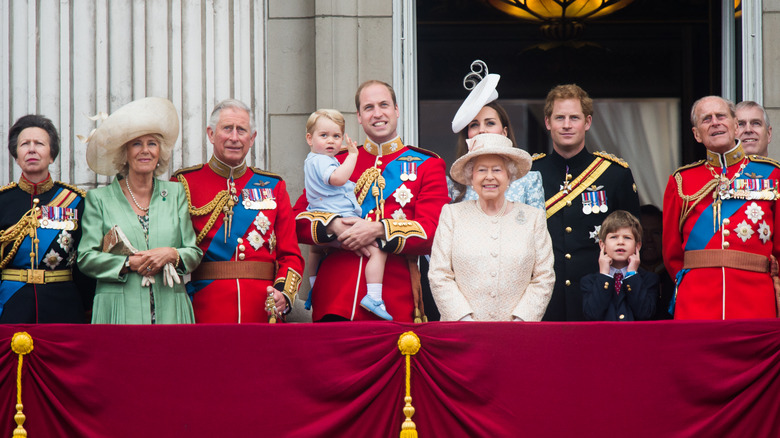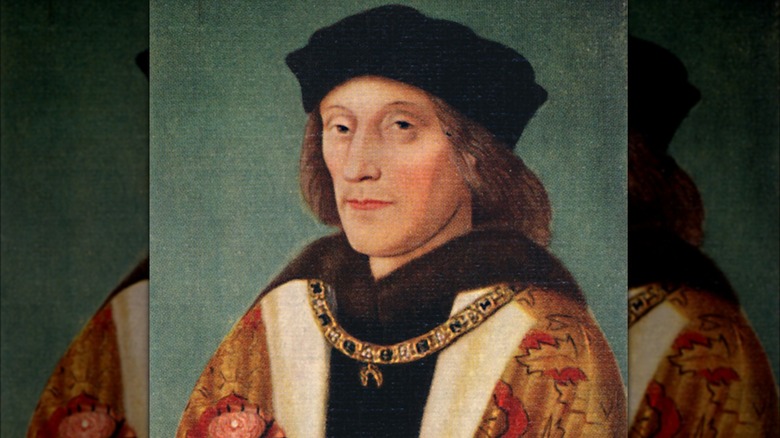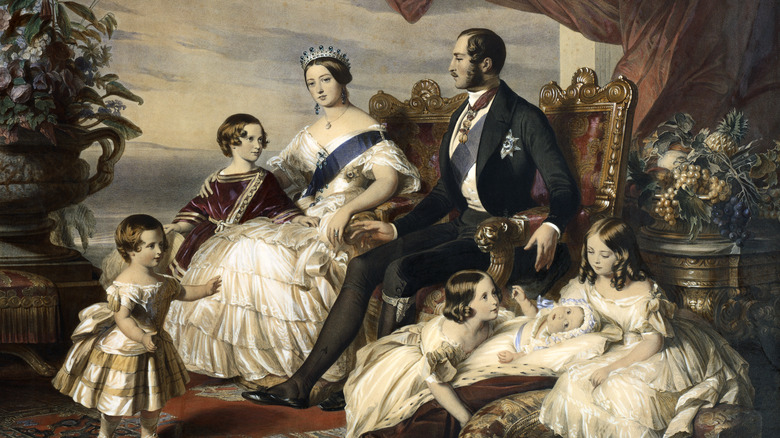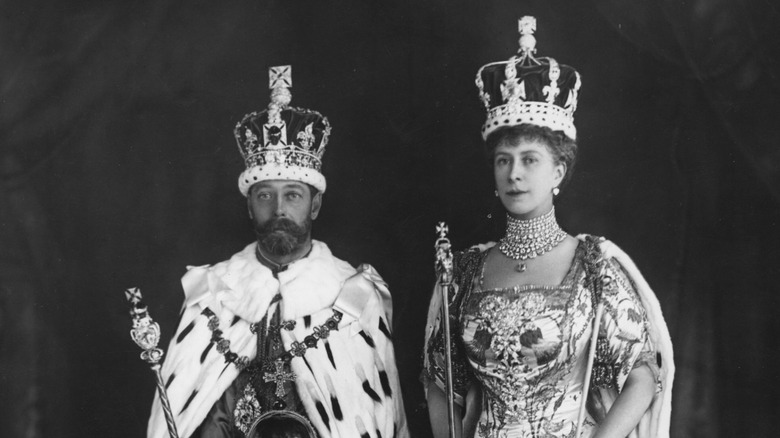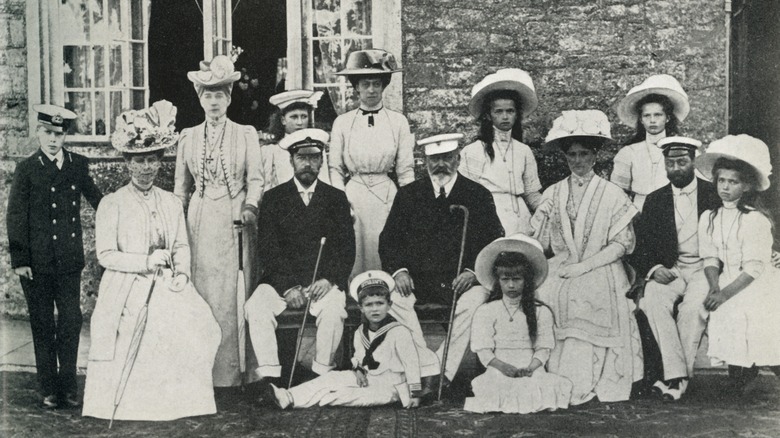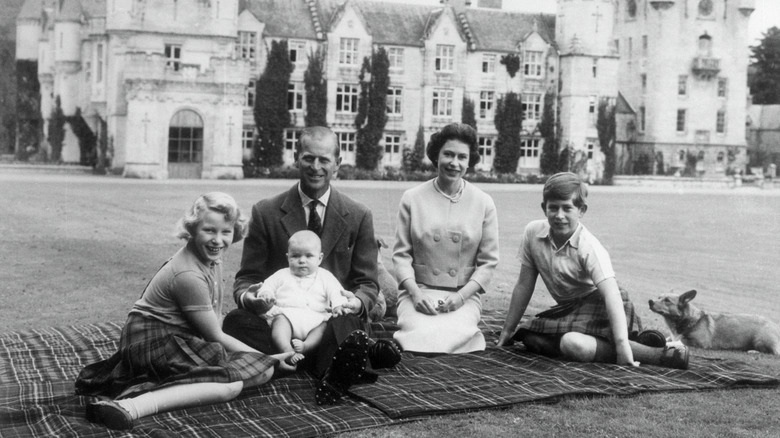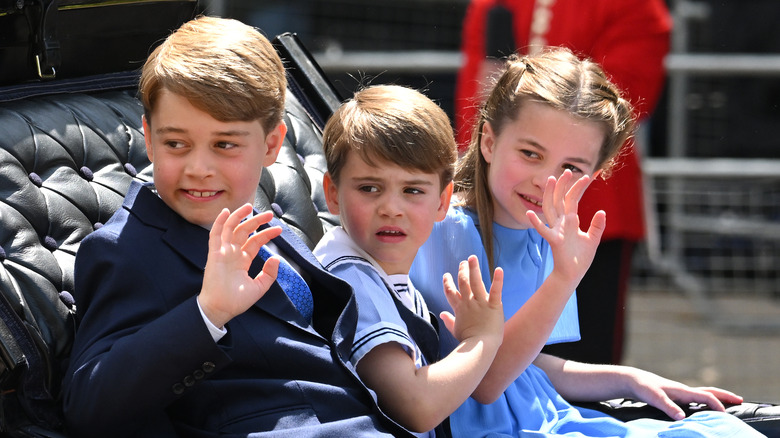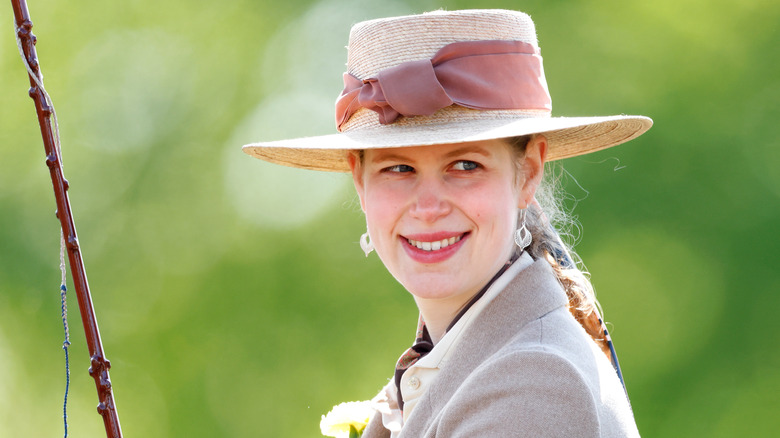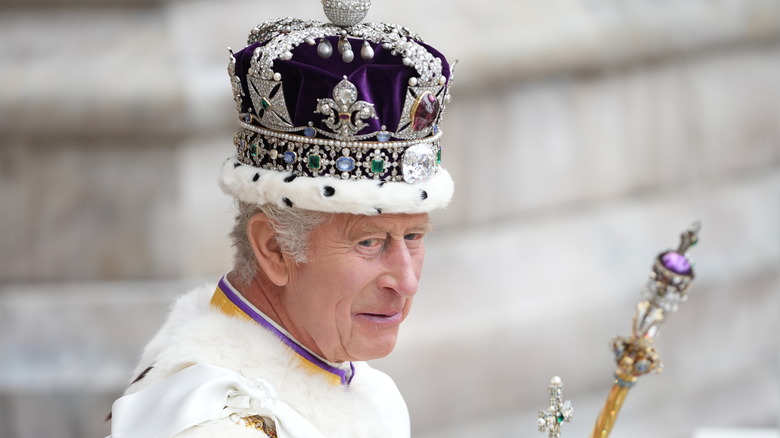The Real Story Behind The Royal Family Name Windsor
What's in a name? When it comes to the British royal family: a lot. For many people, the mere mention of names like King Charles, Queen Camilla, or Prince William conjures up images of incomprehensible power, wealth, and prestige. Not only are they one of the most influential families on the planet, but they're also celebrities in their own right. From Princess Catherine's it-girl status to Prince William paling around with stars like Taylor Swift, the regals generate endless amounts of publicity and fanfare. And with such an astronomic profile, the illustrious family needs no introduction. Their first names are known around the world — however, you might be surprised to learn that the royals also have a lesser known last name that they use on rare occasions. That last name is Windsor.
Throughout the years, the royal brood has been bestowed some truly colorful nicknames by the press. For example, Prince Harry was dubbed a rebel during his hard-partying youth. Then there was Princess Anne, who earned the nickname "her royal rudeness" after getting into several verbal spats with the paparazzi. No matter what you call them, though, the surname Windsor is a mainstay of the royal family. Where exactly did the name come from? According to the genealogical data site Forebears, Windsor can be traced back to the 9th century and is likely derived from the Old English words for "wind" and "shore." Windsor became the official royal surname in the early 1900s, but it has historical and modern roots that run even deeper.
For centuries, the royal family didn't have a last name
When you're as famous as the royal family, there's no need for a last name. The royals are known all throughout England, from London to the furthest reaches of the countryside — and that has been the case for eons. In the past, the royals identified themselves not by a last name but by the name of the royal house from which they hailed. A royal house, or dynasty, refers to a specific bloodline within the royal family tree.
As the British royal family's website explains, house affiliations were passed down through the sovereign's direct paternal lineage. When a married female sovereign was succeeded by her heir, power would be ceded to a new house. Likewise, one house would sometimes overthrow another, resulting in a transfer of leadership. Consequently, ruling houses were subject to change every few generations or so. England's most enduring dynasty was the Plantagenet House, which held power from 1154 to 1485.
While House affiliations were helpful for letting the masses know who was in control, they were also a source of fierce conflict between rivals. In 1455, two royal houses, the Yorks and the Lancasters, started a civil war for control over England. The conflict, which was known as the Wars of the Roses, dragged on for three decades. In 1485, Henry Tudor won the war on behalf of the Lancasters and was declared King Henry VII. His victory ushered in the Tudor House dynasty, which ruled the country for several generations.
The house of Windsor used to be called the house of Saxe-Coburg and Gotha
In 1714, George I was crowned the king of England. As noted by the royal family's website, George wasn't a frontrunner to inherit the throne — in fact, he was 52nd in the succession line. However, under British law, the sovereign must be a member of the Church of England, which practices the Protestant faith. Fortunately for George, everyone ahead of him in the succession line was Catholic and therefore disqualified from taking the throne. Since George was a member of the Hanover House, his ascension marked the beginning of a new era called the Hanoverian dynasty.
The Hanoverian dynasty lasted for over a century and ended with George's great-great-granddaughter, Queen Victoria. In February 1840, Victoria married Prince Albert, a nobleman from the German towns of Coburg and Gotha. After tying the knot with Victoria, Albert relocated to England and assumed the title Prince Albert of Saxe-Coburg and Gotha. The couple had nine children, thereby ensuring that the Crown would remain with their bloodline. However, due to royal tradition, Victoria's children did not assume her ties to the Hanover House. Instead, they took the name of Albert's house.
Victoria ruled for 63 years, making her one of the longest-reigning monarchs in British history. Upon her death in 1901, she was succeeded by her eldest son, King Edward VII. Since Edward was considered a member of the Saxe-Coburg and Gotha House, a new dynasty was born and the Hanover House became defunct.
The royal family adopted the surname Windsor in 1917
When King Edward VII died in 1910, the Crown was passed to his son, George V. George proudly bore Saxe-Coburg and Gotha, the house name of his German-born grandfather, Prince Albert. But within a few years of his ascension, Europe plummeted into political disarray as Austria-Hungary feuded with several neighboring countries. In 1914, the conflict reached a boiling point and World War I erupted. In response, England joined the allied powers, subsequently pitting themselves against Austria-Hungary. On the flip side, several countries allied themselves with Austria-Hungary — including Germany.
As the war plowed forward, Germany carried out a brutal bombing campaign against England. German warplanes dropped hundreds of explosives on English towns and cities, driving citizens into cramped public bomb shelters. England also paid a hefty economic toll for the war, and the country suffered from widespread food shortages. First, Germany swarmed England with colossal aircrafts called Zeppelins, which dropped bombs indiscriminately across the nation. Then, in 1917, German troops employed lethal new warplanes called Gothas. "They came at night," one survivor recalled, according to Imperial War Museums. "The city, as you know, was all bombed. ... It frightened you, because not one comes over, but a great flock of Gothas."
As a result of Germany's ruthless war tactics, anti-German sentiment ran rampant throughout England. Before long, King George acquired a sour taste for his house's name. Thus, in 1917, the monarch ditched the name Saxe-Coburg and Gotha and adopted the English-sounding Windsor instead.
The royals floated several different names before choosing Windsor
Choosing a new name is a lofty task, especially when you're the King of England. But given the animosity between Britain and Germany during WW1, King George V was eager to shed his Germanic house name, Saxe-Coburg and Gotha, and replace it with something definitively Anglican.
During the process, George and his staff floated several different monikers before landing on Windsor. According to the National Archives, the name Tudor-Stewart was initially on the table. However, Tudor had previously belonged to the Tudor House, which produced unpopular rulers like King Henry VIII and Queen Mary I (also known as Bloody Mary) — thus, it was thought to be tainted. George also considered using the names of bygone dynasties like York, Lancaster, and Plantagenet. A few other contenders were D'Este, Fitzroy, and, aptly, England. Finally, a royal advisor came up with Windsor — a name that hadn't previously been used — and it resonated with George.
On July 17, 1917, George issued a statement unveiling the new royal family name. In his announcement, which was published in London Gazette, the sovereign wrote, "Now, therefore, We, out of Our Royal Will and Authority, do hereby declare and announce that as from the date of this Our Royal Proclamation Our House and Family shall be styled and known as the House and Family of Windsor." With this declaration, the king emphasized that Windsor would not only be the name of his royal house, but also the family surname.
Queen Elizabeth's children were given a new last name
Following the switch to Windsor in 1917, the royal family's surname survived for several decades without any shakeups. Then, in 1952, Queen Elizabeth II became the ruler of England and ushered in a new era for the royal family. Throughout her iconic 70-year reign, Elizabeth underwent a stunning transformation and helped modernize the monarchy's image. At the time of her ascension, Elizabeth was already married to her husband, Prince Philip. Per tradition, the queen was expected to take her husband's last name, Mountbatten. However, Elizabeth made the unconventional decision to keep Windsor as her family's surname.
According to royal biographer Sally Bedell Smith, Elizabeth's refusal to adopt Philip's surname caused conflict between the royal couple. In her book, "Elizabeth the Queen: The Life of a Modern Monarch," Smith explained that Philip felt slighted by his wife's decision. "I am the only man in the country not allowed to give his name to his children," Smith quoted the prince as saying (via Vanity Fair). "I'm nothing but a bloody amoeba."
In 1960, Elizabeth and Philip seemingly reached a compromise: The pair decided to change the royal moniker to Mountbatten-Windsor, a combination of both surnames. According to the royal family's website, the couple chose the hyphenated last name because they wanted their bloodline "to be distinguished from the rest of the Royal Family (without changing the name of the Royal House), as Windsor is the surname used by all the male and unmarried female descendants of George V."
Not every royal family member uses their surname
Although the royal family doesn't need to use a last name, they do keep Windsor in their back pocket just in case it ever comes in handy. And every once in a while, the royal surname does prove beneficial — especially when the regals need to sign their names on legal documents. For example, when Princess Anne married her first husband Captain Mark Phillips in 1973, she utilized the surname Mountbatten-Windsor on her marriage certificate.
Royal family members with the title of HRH Prince or Princess can technically opt out of using their surname. This rule applies to prominent royals like Princess Catherine, Prince William, Prince Edward, and the like. But even with this guideline in place, some royals have adopted other surnames as stand-ins for Windsor. Case in point: Prince William and Prince Harry used the last name Wales on official documents during the '80s and '90s. The brothers borrowed the moniker from their father, King Charles III, who was styled as the Prince of Wales at the time.
Similarly, when William became a father to his own brood, his children adopted the surname Cambridge in honor of his royal title. When Queen Elizabeth II died in 2022, William took Charles' place as the Prince of Wales. Subsequently, Prince George, Princess Charlotte, and Prince Louis took Wales as their surname.
Royals without an official title use the surname Windsor
When it comes to the sovereign's immediate family, the monarchy has a strict protocol for styling and naming each member. However, in the case of distant family members, the name game is much more simplified. Some members of the royal family are several branches removed from the sovereign — thus, they are recognized as part of the bloodline but don't qualify for a royal title. As such, some of those family members inherit the surname Windsor. This is true for several royal kinfolk, including Lady Marina, Lady Amelia, and Lord Downpatrick. The sibling trio are the grandchildren of Queen Elizabeth's first cousin, Edward, Duke of Kent. The regal surname also belongs to two of Queen Elizabeth's grandchildren, Lady Louise and James, Viscount Severn.
In some cases, direct descendants of the sovereign may decide to forgo their royal surname and embark on a different nomenclatural path. That was the case for Princess Anne's children, Peter Phillips and Zara Tindall (née Phillips). When these royal siblings were born, Anne was determined to raise them in a relatively normal manner — thus, she declined to give them royal titles. In lieu of Windsor, Anne's children took their father's surname. "I think it was probably easier for them," Anne told Vanity Fair in 2020, "and I think most people would argue that there are downsides to having titles. So I think that was probably the right thing to do."
The sovereign of England can change the family surname
When King Charles III ascended the throne in 2022 at age 73, he was the oldest to ever become king in Britain's history. Charles' age had many royal watchers looking even further into the future and wondering what will happen when Charles' son, Prince William, becomes king. When William eventually does inherit the throne, he'll have the authority to make numerous changes within the monarchy — and just like his grandmother, he will technically be able to change the family surname.
Like all monarchs, William will also have the option to choose a new first name. According to royal expert Keith Roy, ascending sovereigns will sometimes change their first name to symbolize a new beginning. As Roy told Global News in 2022, "If you have a name that doesn't align with what you want to accomplish you would change that name to line it up with some of your predecessors and adopt a new persona and a new direction in your position as the Crown."
Just because William will one day be able make these changes doesn't mean he will. In fact, many experts agree that the future king is unlikely to alter his or the family's name. "We live in a different era where the public feels much more connected to the individuals in the Royal Family," Roy shared. "And therefore, a name change would feel weird both to the individual and to the public."
